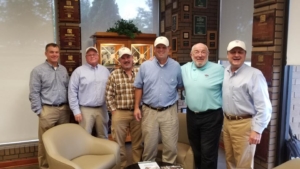It’s All About the People
Recently I came across this in Material Handling Wholesaler. It is well worth reading and talks to elements of the management job that we feel are critical for successful businesses.
7 Steps to Turn Employee Potential into Performance
Imagine on Monday, you discover that your meticulous, rule-following accountant and creative, eccentric marketing person have switched positions. How’s this likely to work out? In truth, some variation of this misalignment is common in most organizations.
The Waybeloe Potential Corporation was operating at the break-even point for the past five years. The CEO, Harvey Waybeloe was frustrated. Another CEO told him about an employee-alignment process that was delivering amazing results for other companies. Out of desperation he decided to try it. Within two years, profits increased from break-even to $3.2 mm! The fix? Putting the right people in the right seats!
Most business leaders say that 80% of the work is done by only 20% of the workforce. This 20% are the top performers. They usually produce 3-4 times more than the others. The main reason is due to job alignment rather than attitude or drive. Here’s evidence: It’s common for top performers to be moved or promoted and then become poor performers. Likewise, many poor performers become top performers when moved to appropriate roles. Bottom line: everyone can be a top or poor performer depending on how well the work aligns with their innate characteristics.
How do you deliberately create an organization where people’s work is aligned with their innate characteristics (abilities)? Here’s an overview of a proven process that was used above.
1. Shift your mindset from focusing on skills, experience, and education to innate characteristics first
It’s common for people who are “great on paper” to get hired and become poor performers. In that same vein, many top performers started off lacking in the “required” skills experience and education. When people’s work aligns with their innate characteristics, they can utilize their natural abilities and unleash their passion for their work. Also, the best training and management will not turn poorly aligned employees into top performers.
2. Select the right assessment tool
Many organizations use personality assessments in the hope of gaining more objective information about people to set them up for success. However, the results are usually disappointing due to four inherent pitfalls:
• What you think of as personality is mostly surface-level, observable behaviors; not what’s underneath, driving these behaviors. The drivers of behavior are more accurate, predictive, and stable.
• Assessment-takers usually provide different answers based on which of the following they consider: how they actually see themselves, how they believe others see them, and how they want to see themselves.
• Assessment-takers use a specific context or situation to answer the questions. For example, answers to questions related to “extroversion” (sociability and talkativeness) may vary depending on context differences: small vs. large groups, familiar vs. unfamiliar people, level of interest in the topic of conversation, etc.
• If an assessment is used for a job application, the applicant often has an opinion on what traits the employer is looking for and skews the answers accordingly.
• What’s a better option? Select an assessment that delves beneath the personality into what is more core or innate with people. This eliminates the biases of personality assessments and provides more valid and reliable data.
3. Establish trust with the employees
Inform the employees about the company’s commitment to align their work with their natural gifts. Don’t hide things or surprise people. People want to do work they’re good at and enjoy.
4. Develop an understanding of the innate characteristics being measured
Before you can align people’s innate characteristics with their work, it’s essential to understand what these characteristics mean. In other words, how each one impacts the way people think and behave. Now you have the basis to identify which characteristics are needed for different types of positions within your organization
5. Develop clarity on the job duty break-down
It’s important to know what people will do on a day to day basis in each job. The hiring team (direct manager and others with a major stake in position success) meets to gain clarity on the percentage of time spent performing each job responsibility. Group together duties that are very similar in nature (family of duties). Estimate the percentage of time spent working on each job duty family.
6. Determine which innate characteristics are critical and where they need to measure
The hiring team determines which innate characteristic is critical for each job duty family. They also agree on the desired range for each characteristic. For example, on a 1-10 scale the range for creative thinking should be between 7-9. Now you can develop an optimal range for each critical characteristic.
7. Administer assessment & align employees with job functions
Assess both current employees and potential new hires and compare to the desired ranges. Take the appropriate action based on how strong the level of alignment is. Top performers almost always fit into desired ranges for each critical innate characteristic. If this is not the case, you need to adjust your desired ranges based on the data. Here’s more information on aligning employees:
• When current employees don’t align with their jobs evaluate other positions within the company that do align well.
• Openly discuss available options with employees who are misaligned. Develop a plan to shift roles or tweak job descriptions when this is feasible. Frequently, there are other employees who’d be thrilled to trade positions or some duties that better match with their own innate characteristics.
• For applicants applying to open positions, only interview the people who align well with the desired innate characteristics. When you interview people who don’t align, you may be tempted to discount the assessment results. This rarely ends well.
In the end, the most important job of management is to maximize the ROI of its workforce. Peter Drucker said “The task of a manager is to make people’s strengths effective and their weaknesses irrelevant. The most important thing you can ever do as a leader is to put people in a position to excel rather than get by or fail. How are you doing in your most important task?
About the Author:
Brad Wolff specializes in workforce and personal optimization. He’s a speaker and author of, People Problems? How to Create People Solutions for a Competitive Advantage. As the managing partner for Atlanta-based PeopleMax, Brad specializes in helping companies maximize the potential and results of their people to make more money with less stress. His passion is empowering people to create the business success they desire, in a deep and lasting way. For more information on Brad Wolff, please visit:
www.PeopleMaximizers.com.
The time is now.



